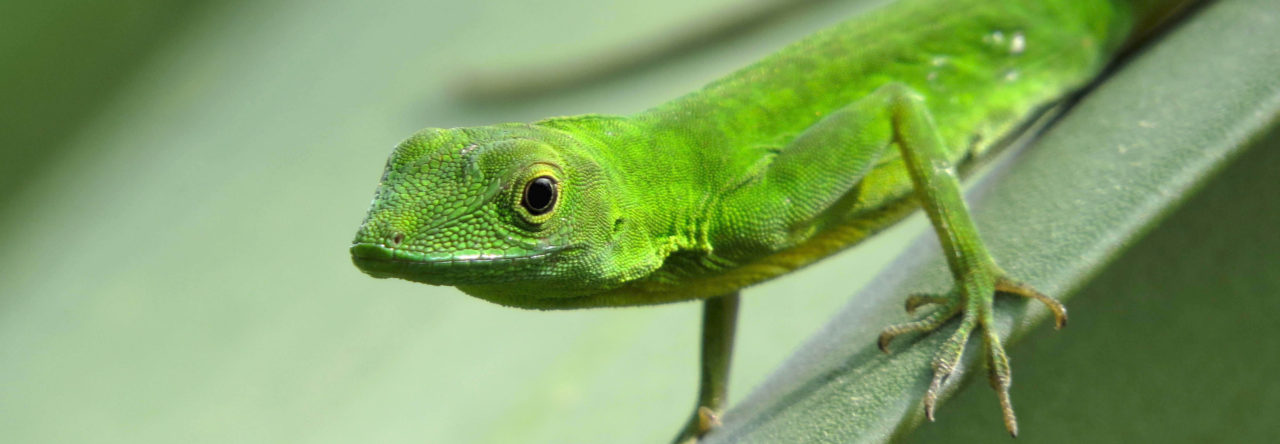After a slow start (believe it? An anole-less first day), the anole talks begin today. There were a couple of omissions and changed times in the previous list, so hopefully all talks and posters are included and correctly listed here. Notably, Dave Steinberg’s talk on head-bobbing was not included in the previous list; he talks today at 1630. I’ve rearranged the talks into chronological order. Two observations become apparent: first, the conference organizers have cleverly backloaded the schedule to keep people from leaving the conference early. There are 9 anole talks on Monday, as opposed to 4 today, 1 on Saturday and 2 on Sunday. Second, some tough decisions are going to have to be made, as there are four occasions in which two talks are scheduled at the same time. Bummer. Here they are:
Stuart, Yoel – Session 35 Friday 14:45, “A real-time test of a classic hypothesis: rapid, replicated character displacement in Anolis carolinensis following invasion by a congeneric competitor”
Bienentreu, Joe-Felix – Session 42, Friday 15:45 “Taxonomy and phylogeography of the Anolis pachypus complex (Squamata: Iguania: Dactyloidae)”
Warner, Daniel – Session 35 Friday 16:45, “Spatial and temporal variation in phenotypic selection after experimental introduction in the lizard Anolis sagrei”
Kolbe, Jason – Session 35 Friday 16:45, “Adaptation and plasticity during Anolis lizard introductions”
Losos, Jonathan – Session 58 Saturday 9:15, “Natural History of the Little-Known Horned Anole of Ecuador, Anolis proboscis, and its equally little-known relative, Phenacosaurus orcesii”
Mahler, D. Luke – Session 89 Sunday 11:30, “Discovery of a short-limbed giant Anolis from Hispaniola supports a deterministic model of island evolution and community assembly”
Wollenberg Valero, Katharina – Session 98 Sunday 15:30, “Diversification within adaptive radiations: the case of Hispaniolan trunk-ground anoles”
Ingram, Travis – Session 130 Monday 14:00, “A new comparative method that does not require pre-assigned ecomorph categories confirms exceptional morphological convergence in Caribbean”
Castañeda, Maria del Rosario – Session 130 Monday 14:15, “Multivariate analysis of the morphological component of ecomorphology in mainland Anolis lizards (Dactyloa clade)”
Powell, Brian – Session 130 Monday 14:30, “Brain Evolution Across the Puerto Rican Anole Radiation”
Crawford, Nicholas – Session 132 Monday 14:45, “The genetics of colorful pigmentation in Anolis lizards”
Harrison, Alexis – Session 130 Monday 14:45, “Correlated evolution of microhabitat, morphology, and behavior in West Indian Anolis lizards: A test of the ecomorph hypothesis”
Schneider, Christopher – Session 130 Monday 15:45, “The genetic basis of phenotypic variation and divergence in Anolis marmoratus”
Leal, Manuel – Session 129 Monday 15:45 “Behavioral flexibility and problem‐solving in lizards”
Steinberg, David – Session 39 Friday 1630 “Heads‐up: signal modulation and receiver distance in anoline lizards”
Sherratt, Emma – Session 130 Monday 16:45, “The deep history of Anolis habitat specialists”
Friday Posters: Castañeda, Maria del Rosario – Poster board 171, “Anolis lizards in the Encyclopedia of Life”
Gubler, Jenny – Poster board 176, “Investigation of the Evolutionary Relationships Among Species of the Anolis cupreus Complex”
Saturday Posters: Otero, Luisa – Poster board 132, “Habitat influence on annual reproductive cycle of Anolis cristatellus in Puerto Rico”
Cantwell, Lisa – Poster board 108, “Response of Anolis sagrei to Acoustic Calls from Predatory and Non-predatory Birds”
Sunday Posters: Mahler, D. Luke – Poster board 336, “A new organization dedicated to the conservation of Anolis lizards: The Anoline Lizard Specialist Group”
Rubio-Rocha, Laura C. – Poster board 396, “Continuous reproduction under a bimodal precipitation regime in a high elevation anole (Anolis mariarum) from Antioquia, Colombia”
Rubio-Rocha, Laura C. – Poster board 397, “Geographic variation in the lower temperature tolerance in the invasive brown anole, Anolis sagrei and the native green anole, Anolis carolinensis”
Vega, Sondra – Poster board 402, “Omnivory in Puerto Rican Anolis lizards“



 AA reader, anole scientist, and anole breeder Veronika Holáňová has written a beautiful book on anole husbandry. I can attest that the photos are exquisite, and here’s what she has to say about it: “It is a book for all Anolis lovers who would like to try to keep them in captivity. In that book I have my experiences with keeping different anole species after many years :-).” The only catch is that it is in Czech, though Veronika says that “maybe one day it could be in English too.” Let’s hope! The book has a
AA reader, anole scientist, and anole breeder Veronika Holáňová has written a beautiful book on anole husbandry. I can attest that the photos are exquisite, and here’s what she has to say about it: “It is a book for all Anolis lovers who would like to try to keep them in captivity. In that book I have my experiences with keeping different anole species after many years :-).” The only catch is that it is in Czech, though Veronika says that “maybe one day it could be in English too.” Let’s hope! The book has a 







 The Dutch Caribbean Natural Alliance has put up a
The Dutch Caribbean Natural Alliance has put up a